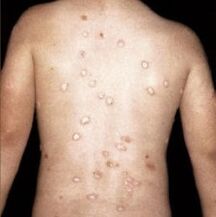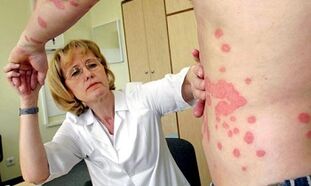
A chronic disease of a non-infectious nature, which, according to statistical data, affects several percent of the entire population, is psoriasis, the symptoms of which are manifested in the form of focal rashes, itchingand intense peeling of the skin.
The disease can develop at any age and regardless of the social environment to which a person belongs. Psoriasis also occurs in men and women. Most often, the disease affects young people under the age of twenty.
A lot of people are interested in the question: “Does psoriasis itch, what are its symptoms and treatment, and most importantly, is it contagious? ” Itchy rash in psoriasis is found in almost 85%cases, but the disease is not contagious at all and is not transmitted by airborne droplets or through household means. It is difficult to treat, but complex therapy almost always gives good results.
Manifestation of the disease
How does psoriasis manifest and what is this disease? Psoriatic plaques often develop first in areas with the most friction, such as the elbows or knees.
In addition, signs of psoriasis can appear on any area of the skin - head, face, back, abdomen, palms, feet, armpits and even on the genitals.
If we consider another similar disease - eczema, it affects the inner part of the flexor surfaces, with psoriasis - the outer part of the knee and elbow joints.
The pathology is chronic and has an undulating course, that is, a person's condition may improve under the influence of treatment methods or, conversely, worsen under theinfluence of negative factors, while remission and exacerbation are usually completely spontaneous.
Relapse can be caused by alcohol abuse, stress, infectious diseases. The severity of psoriasis varies from person to person, and even within the same person, throughout the course of the disease.

The main symptoms of skin psoriasis are plaques, which appear as minor lesions in some areas. In some cases, they can cover the whole body.
Psoriasis progresses over time, especially if no proper action is taken to correct it. The progression of the disease consists of an increase in the periods of exacerbations and an increase in the area of the lesion with the involvement of healthy areas of the skin in the inflammatory process. There are cases when the disease has progressed continuously without periods of remission.
Very often there is such a pathology as onychodystrophy - damage to the nails. This disease can develop on its own, without the attachment of a skin lesion. In addition, psoriasis can contribute to the development of an inflammatory process in the joints - psoriatic arthritis (a disease of the small joints of the lower extremities and hands), and onychodystrophy is observed in about 15% of patients with psoriasis.
There are many ways to treat this disease, but due to the tendency of the disease to relapse and get worse all the time, psoriasis is very difficult to treat. Full recovery is almost impossible, that is, staying with a person until the end of their life, but with proper treatment and following all medical prescriptions, longer periods of remission can. be achieved.
Reasons
Medicine today does not know the real cause of this pathology, but it has been proven that immune system dysfunction, neurological disorders and metabolic disorders can cause the disease. There are also a number of factors that can trigger the development of the disease:
- Genetic predisposition,in other words, simple inheritance. Experts say signs of psoriasis can be found in people whose blood relatives suffered from psoriasis. In addition, if one of the parents is sick, the risk of developing the disease is 20%, and if both parents - up to 50%. This is due to the existence of certain genes responsible for the development of dermatological changes. The first signs of hereditary psoriasis usually appear before the age of 25.
- Neurological disorders.Any emotional shock, nervous tension, chronic fatigue can provoke the development of the disease. In addition, in people with psoriasis, any stressful situation can provoke an exacerbation of the disease.
- Hormonal failure.Any pathological changes in the functioning of organs of the endocrine system can trigger the development of the disease.
- Violation of the metabolic process.Metabolic disorders associated with a lack of useful trace elements and vitamins in the body can cause psoriasis.
- Helminthic invasion.Certain types of parasites can cause illness. Numerous laboratory studies were carried out, the results of which showed that many patients with psoriasis were infected with giardiasis, opisthorchiasis, ascariasis, enterobiosis. The fact is that in the process of their vital activity, helminths emit toxic substances that poison the whole body. This leads to an exacerbation of chronic diseases and a significant decrease in immunity.
- Viral infections,which also attack the human immune system.
From the above, it becomes clear that the process of developing psoriasis, in one way or another, is associated with disturbances in the work of the body's defense mechanisms. Psoriasis on the body can develop under the influence of a variety of triggers, or under the influence of factors such as an unbalanced diet, climate change, alcohol abuse, and smoking.
The clinical picture and types of psoriasis
How does psoriasis start? The first symptoms of the disease are the appearance of reddish patches and scaly patches that itch and look like lichen. Over time, the spots peel off, and a more dense scaly layer is found under them.
When the disease begins to progress, the so-called Kenber phenomenon is observed, when plaques appear in places of skin trauma (with wounds, cuts, burns).
Varieties
There are several types of psoriasis, each with a specific clinical picture:
- Plaque (true psoriasis)is the most common form of the disease, occurring in over 80% of all patients. The skin becomes inflamed, dry and thickened, with raised areas above, which are covered with light silvery scales. The skin in these areas is hot to the touch and is constantly flaking. After peeling, there are reddish inflammatory foci, which are very often damaged and bleed. The inflammation can merge into large foci. With psoriasis of the elbows and knees, the peeling is not so pronounced.
- Teardrop-shaped- there are many small, dry, rounded inflammations of red or purple color, rising above the surface of the skin. Guttate psoriasis covers large areas of the body. The first signs of the disease may come after a sore throat or pharyngitis, which is caused by a strep infection.
- pustularis the most complex form of the disease. It looks like foci of vesicular rashes raised above the surface of healthy skin. These bubbles are filled with exudate. Around the pustules, the skin turns red, swells, thickens and flakes off. When a secondary infection is attached, the blisters are filled with purulent fluid. Typically, this psoriasis is limited and affects specific areas, such as the lower leg and forearm. In severe cases, the inflammation begins to spread further along the surface of the skin and the spots from the rash merge into a single focus.
- Psoriatic arthritis- joints and connective tissue are involved in the pathological process. The main manifestation of this form is severe itching. In addition, the skin of the joints of the fingers becomes painful, swollen, peels and flakes.
- Onychodystrophy (psoriasis of the nails)may look like a yeast infection. With this disease, the appearance of the nails changes, they become brittle and exfoliate, the color of the nail bed and the plaque itself can turn yellow or gray. In addition, white spots, dots and cross lines appear on the nails and under the nails. The skin under and around the nails becomes firm. Very often onychodystrophy results in the loss of the nails.
Additional symptoms of psoriasis include:
- bleeding wounds (in places of skin trauma); erosion of the nails
- ;
- intense itching;
- fever, swelling and joint pain in psoriatic arthritis (not always).
How the disease progresses
There are several stages in the course of the disease:
- Progressive.This is the initial stage of the disease. It is characterized by exacerbations, in which an increase in the number of new rashes occurs.
- Stationary.At this point, the picture of the disease remains unchanged, that is, the rash and other symptoms of psoriasis neither increase nor decrease.
- Regression step.The last stage of the disease, which proceeds without rashes.
Depending on the prevalence of the inflammatory process, the disease can be:
- limited- small areas of the skin are affected;
- common- large areas of the skin are affected;
- generalized- almost the entire surface of the body is affected.
Among other things, psoriasis is considered a seasonal illness, meaning that all symptoms worsen with the season. Most people usually get worse in winter or summer. In some patients, this process is not associated with a change of season.
Diagnostics

How is this disease diagnosed? The diagnosis of psoriasis is mainly based on examination by a dermatologist. Examination reveals the shape and degree of the lesion.
In some cases, a differential diagnosis is made to distinguish psoriasis from another skin disease. How do you recognize that a patient has this particular condition?
As already mentioned, in psoriasis, Kenber's phenomenon is observed, which is not inherent in skin pathologies. Another symptom should also be taken into account, when a light edge appears around a new papule, which has not yet begun to peel off - a kind of vascular reaction, indicating the further progression of the disease.
Sometimes a skin biopsy is used to make the diagnosis more accurate, or tests are done to detect an inflammatory process in the blood. Once diagnosed with psoriasis, you should start treatment immediately.
Care
Drugs
The main therapy is the use of topical preparations in the form of ointments, gels, creams and sprays.
These medicines contain ingredients that stop excessive cell division of the skin and relieve an unpleasant symptom such as itching. There are a number of substances that effectively fight this disease:
- Glucocorticoid hormones.They relieve inflammation and normalize the immune system.
- Vitamin D.The use of medicines containing vitamin D will be more effective when the disease reaches the stationary stage, when the patient's condition is stable. Good results are obtained by taking these drugs in combination with ultraviolet irradiation procedures.
- Silicon.Improves the condition of the skin, has absorbent properties and absorbs antigens involved in the development of the disease.
- Tarhas a good effect on the foci of inflammation, which are localized on the head.
- Lecithin.Promotes rapid tissue regeneration. Preparations containing this substance help the body to cope with inflammation faster.
- Activated Zincin no time eliminates redness and relieves itching.
Patients are also prescribed drugs from the following groups:
- corticosteroids- normalize metabolic processes;
- cytostatics- prevent cell division, but can weaken the body's defense mechanisms;
- immunomodulators- also regulate immune responses, but their effectiveness is questioned;
- non-steroidal- relieves inflammation and itching.
Vitamin complexes are prescribed in combination with these drugs.
Besides drug treatment, the following methods are very popular:
- Hirudotherapy.Treatment of leeches improves blood circulation and normalizes immune mechanisms.
- Cryotherapy.A special way of "freezing" relieves itching, swelling and inflammation.
- Ultraviolet irradiation.These short-term procedures are associated with the introduction of special drugs.
Warning!Self-medication for psoriasis is unacceptable, since many drugs have contraindications and are prescribed by a specialist taking into account only the individual physiological characteristics of the patient.

Children generally have a less severe course of psoriasis than adults, so local treatment works well, and even with exacerbation, repeated treatment can lead to long-term remission.
Even if a child is diagnosed with a severe form, with adequate and timely treatment, the prognosis will be more or less favorable.
The main rule for parents is to know how to identify the characteristic signs of psoriasis and start fighting this disease immediately!
Traditional medicine
Traditional medicine recipes are often used to treat psoriasis. Compresses based on medicinal herbs will be effective.
To prepare the compress, grind 4 tbsp. tablespoons of dry herbs and pour a glass of boiling water, then let it brew. In the broth you need to moisten the gauze and apply it to the sore spots.
The following plants have healing properties:
- calendula;
- horsetail;
- walnut leaves;
- celandine;
- millefeuille;
- sweet clover;
- burdock;
- blackcurrant leaves.
You can also prepare an oral tincture. For this, 1 tbsp. a spoonful of dry herbs should be poured with a glass of boiling water, insisted for 8 hours, strain and drink 100 ml twice a day, preferably half an hour before meals. Suitable for collecting herbs:
- St. John's Wort;
- celandine;
- sequence;
- marshmallow;
- valerian.
Warning!Some of these herbs can cause side effects, therefore, before starting treatment, you should familiarize yourself with all the contraindications.

Medicinal ointments for home treatment are very popular. Here are some effective recipes:
- Burn the dried rose hips and mix the ashes with petroleum jelly. The ointment should be applied to the affected areas every day.
- Grind the celandine leaves to obtain 2 tbsp. spoons, add lanolin and petroleum jelly. Ointment to treat inflamed skin.
- Mix the tincture of the string with lanolin and petroleum jelly and rub into the psoriatic patches.
- Grind the roots of the meadowsweet, mix with oil or petroleum jelly, boil the resulting ointment, cool and smear the painful spots.
Soothing herbal teas are beneficial. They can be brewed from motherwort, oregano, chamomile, mint, thyme, valerian, linden, peony.
Traditional medicine does not guarantee 100% of the result, it is better to combine it with the main treatment.
Psoriasis and pregnancy
Many women with psoriasis who are in a position worry about the behavior of the disease during this time.
Psoriasis is an unpredictable disease, so it is difficult to answer the question: "How to determine the course of the disease during pregnancy". Symptoms of psoriasis may start to progress, stay stationary, or decrease. There are cases when after childbirth the disease has completely disappeared.
Every pregnant woman fears that the disease could be passed on to her baby, but the disease itself is not hereditary, but only a predisposition to it.

While breastfeeding, if the mother is on treatment with strong drugs, breastfeeding is very dangerous because the substances can harm the health of the baby. In this case, you must stop the treatment or transfer the baby to artificial feeding.
The disease does not affect conception and intrauterine development of the fetus, but the drugs that the pregnant woman is taking can have negative consequences, so it is important to consult your doctor when planning pregnancy, which will cancel some.
Prevention
This disease cannot be prevented, but its manifestations can be considerably reduced. In order to reduce the symptoms of the disease, you should adhere to the following preventive rules:
- Try not to get nervous and learn to keep your emotions in check. Natural sedatives can be used to make this task easier.
- Reduce your intake of salty, smoked, spicy, fried and fatty foods, as well as honey, citrus, chocolate and coffee.
- Wear clothes made from natural fabrics.
- Choose low pH personal care products that won't dry out or irritate sore skin.
- Be careful with medications as many can cause psoriasis flare-ups, antibiotics are especially dangerous.
- Stop smoking and alcohol.
- Avoid direct sunlight.
Psoriasis is one of the most common skin diseases, the nature of which is not yet fully understood. The disease causes a lot of inconvenience, worsens the quality of life and lowers a person's self-esteem.
It can happen suddenly and unfortunately no one is safe from this disease. That is why it is very important to know how this pathology manifests itself in order to consult a doctor in time and begin treatment.























